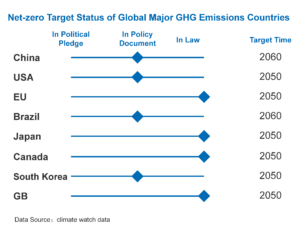09 Feb 2022
Low-carbon Practices of Chemical Enterprises in Line with Carbon Neutrality
9 February, 2022

Carbon emissions has been a global concern, and the Intergovernmental Panel on Climate Change (IPCC) report released in November 2018 suggested that the world must limit global warming to 1.5 °C avoid extreme events and disasters. This target will only be achieved if the global emissions can be brought to zero by mid-century stay.
Globally, countries have reached consensus on climate change and signed the Paris Agreement, international authorities agreed to establish an institutional framework for global climate governance beyond 2020. Later on, carbon neutrality has become a global trend as top global emitters of carbon dioxide have successively pledged to net zero-emission targets and issued policy documents to reduce carbon emissions. Some developed countries [the European Union, the United Kingdom, Canada and Japan], step further and enshrine in law the objective of becoming climate neutral by 2050 which indicates a greater responsibility.

Carbon neutrality means companies, groups or individuals measure the total amount of greenhouse gas emissions directly or indirectly generated within a certain period of time, and then absorb the released carbon by ‘offsetting’, such as through afforestation, energy conservation and emission reduction, etc., to offset the CO2 produced hence achieving “zero emissions” of carbon dioxide.

Low-carbon Practices of Chemical Enterprises
The biggest impact of carbon neutrality on the supply chain of the manufacturing industry is the constraints on carbon emissions. For chemical companies that have long been considered high energy consumption and high emissions, the challenge in the context of carbon neutrality is to develop a low-carbon production model. Therefore, it is necessary for enterprises to find a new model of development without increasing or even reducing carbon emissions. The discussion and exploration of carbon neutrality within industry mainly focuses on two directions :
1. Lower Energy Consumption Rate in Production
Coal, electricity, natural gas and other fuels are used in the chemical production process. One direction is to reduce energy consumption and improve energy efficiency. Meanwhile, increasing the adoption of green energy in the production process, such as solar and wind. Another direction is to reduce CO2 emissions from the process, such as carbon capture technologies. Carbon Capture and Storage (CCS) refers to a technology that collects CO2 produced by emission sources such as large power plants, steel plants, and chemical plants, and stores it in various ways to prevent it from being emitted into the atmosphere.

2. Development of Bio-based Materials
The low-carbon practice on the product side focuses on substituting traditional fossil-based materials with bio-based materials, thereby, the downstream applications could reduce the dependence on fossil-based products. Products made of bio-based raw materials can reduce the use of fossil energy and contribute to emission reduction.


